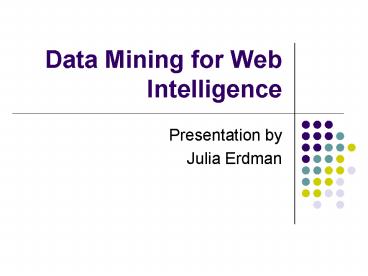Data Mining for Web Intelligence - PowerPoint PPT Presentation
1 / 20
Title:
Data Mining for Web Intelligence
Description:
i.e. Amazon.com, Realtor.com. Random surfing. Design Challenges ... i.e. many sites have a link to weather.com, but generally are not weather sites ... – PowerPoint PPT presentation
Number of Views:98
Avg rating:3.0/5.0
Title: Data Mining for Web Intelligence
1
Data Mining for Web Intelligence
- Presentation by
- Julia Erdman
2
Data Mining the Web
- Searching, comprehending, and using the
semi-structured data on the web poses a
significant challenge over data mining in a
commercial database system - The data from the web is more sophisticated and
dynamic - Data mining helps search engine find high-quality
web pages
3
Why Data Mining?
- Challenges of data mining the web
- Web page complexity far exceeds the complexity of
any traditional text document collection - The Web constitutes a highly dynamic information
source - The Web serves a broad spectrum of user
communities - Only a small portion of the Webs pages contain
truly relevant or useful information
4
Why Data Mining?
- Approaches to accessing information on the web
- Keyword-based search or topic-directory browsing
- i.e. Google, Yahoo
- Querying deep Web sources
- i.e. Amazon.com, Realtor.com
- Random surfing
5
Design Challenges
- Traditional schemes for accessing data on the web
are based on text-oriented, keyword-based web
pages - The current access schemes must be replaced with
more sophisticated schemes in order to exploit
the Web completely
6
Access Limitations
- Lack of high-quality keyword-based searches
- A search can return many answers
- i.e. searching popular categories, like sports or
politics - Overloading keyword semantics can return many
low-quality answers - i.e. a search for jaguar could be for an animal,
car, sports team - A search can miss many highly related pages that
do not contain the posed keywords
7
Access Limitations
- Lack of effective deep-Web access
- There are at least 100,000 searchable databases
on the Web with high-quality, well-maintained
information, but are not effectively accessible - There is an extremely large collection of
autonomous and heterogeneous databases, each
supporting specific query interfaces with
different schema and query constraints
8
Access Limitations
- Lack of automatically constructed directories
- A topic or type-oriented Web information
directory creates an organized picture of a web
sector - Developers must organizes these directories
manually - Costly
- Provides only limited coverage
- Not easily scalable or adaptable
9
Access Limitations
- Lack of semantics-based query primitives
- Most keyword-based searches only allow of small
set of search options
10
Access Limitations
- Lack of feedback on human activities
- Web links may not be updated frequently,
regularly, or at all - Changes in access frequency do not automatically
adjust search results
11
Access Limitations
- Lack of multidimensional analysis and data mining
support - Cannot drill deeply into sites in order to find
the data we are looking for
12
Mining Web search-engine data
- Current keyword-based search engines have several
deficiencies - A widely covered topic can contain hundreds of
thousands of documents - Highly relevant documents may not contain the
keywords used in the search
13
Analyzing the Webs link structure
- When one web page contains a link to another,
this can be considered an endorsement of the
linked page - Collected endorsements of the same page from many
different web authors leads to an authoritative
web page - A hub is a single web page that contains a
collection of links to authoritative web pages
14
Classifying Web documents automatically
- Generally, human readers classify Web documents,
but an automatic classification is highly
desirable - Hyperlinks contain high-quality semantic clues to
a pages topic, which can help achieve accurate
classifications - However, links to unrelated sites can cloud the
classification - i.e. many sites have a link to weather.com, but
generally are not weather sites - Automatic classification can determine what
classification a web page belongs to, but not to
which classification it does not belong to
15
Mining Web page semantics structures and page
contents
- Fully automatic extraction of Web page structures
and semantic contents can be difficult due to the
limitations on automated natural-languages
parsing - Semiautomatic methods can recognize a portion of
such structures - Then further analysis can see how the contents
fit into these structures
16
Mining Web page semantics structures and page
contents
- To identify the structures to extract, either an
expert manually specifies the structures, or
techniques must be developed to automatically
produce the structures - Or developers can use Web page classes for
automatic extraction - Semantic page structure and content recognition
will provide for more in-depth analysis of Web
pages
17
Mining Web dynamics
- Contents, structures, and access patterns change
on the Web - Storing historical data about Web pages assists
in finding changes in content and links - But due to phenomenal breadth of the Web, it is
impossible to store images and updates - Mining web logs records can provide quality
results - This data needs to be analyzed and transformed
into useful, significant information
18
Building a multilayered, multidimensional Web
- Systematically analyze a set of Web pages
- Group closely related local Web pages or an
individual page into a cluster, called a semantic
page - The analysis provides a descriptor for the
cluster - Then create a semantics-based, evolving,
multidimensional, multilayered Web information
directory
19
Questions? Comments?
20
- Jiawei H. Chang, K.C.-C. "Data mining for Web
intelligence" IEEE Computer, Volume 35, Issue 11,
Nov. 2002. pp. 64- 70.































